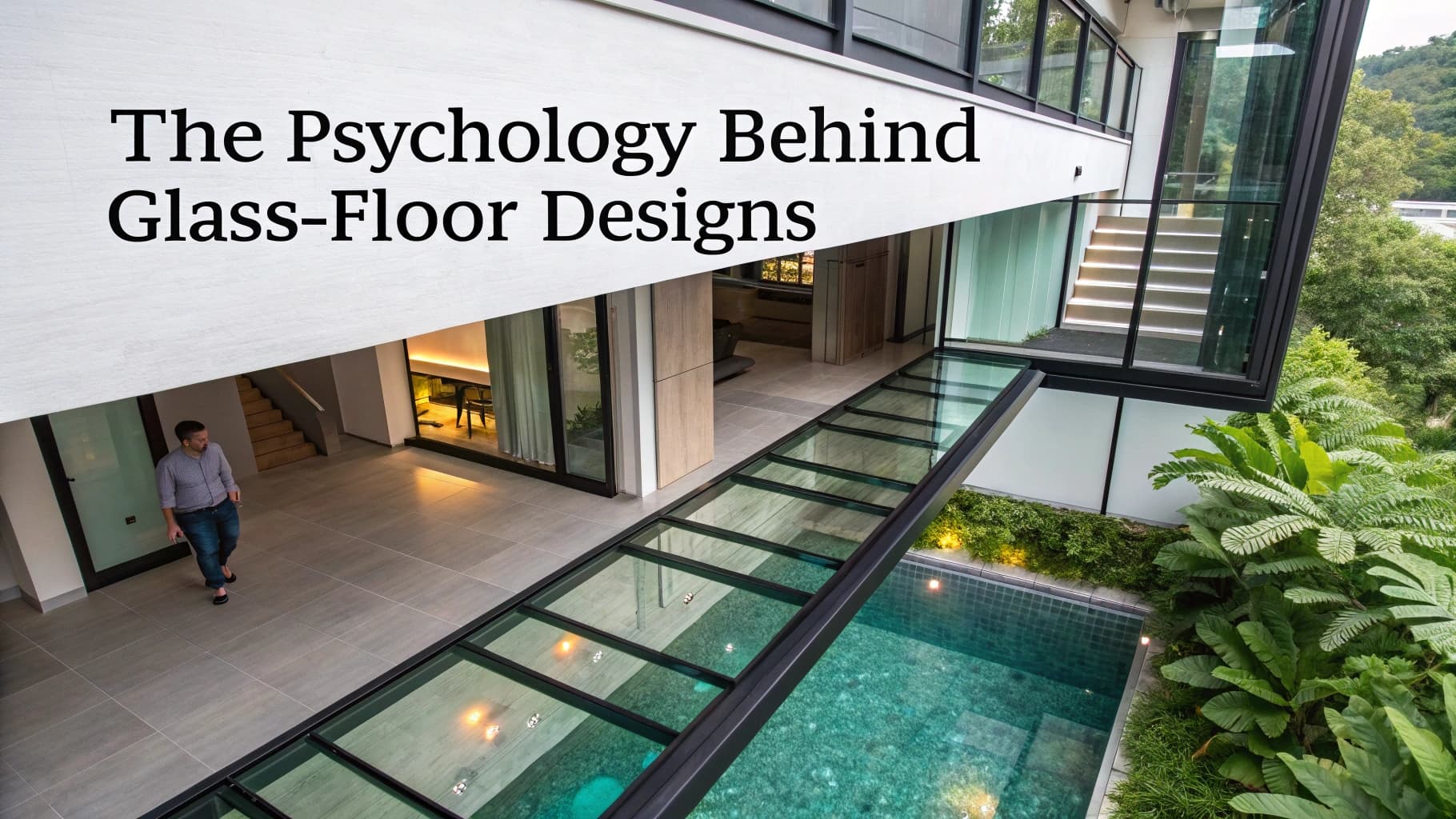Glass-floor designs have emerged as a captivating element in contemporary architecture and interior design, transforming spaces into visually striking environments. These innovative structures, often made from tempered or laminated glass, allow for a unique interplay of light and space, creating an illusion of continuity between different levels of a building. The use of glass flooring can be traced back to ancient civilizations, where transparent materials were utilized for aesthetic purposes.
However, the modern application of glass floors has evolved significantly, incorporating advanced engineering techniques and safety measures that enable their use in a variety of settings, from residential homes to commercial spaces and public buildings. The aesthetic appeal of glass floors is undeniable; they can enhance the beauty of a space while also serving functional purposes. For instance, in retail environments, glass floors can showcase products beneath them, creating an engaging shopping experience.
In residential settings, they can connect different areas of a home, allowing natural light to flow freely and creating a sense of unity. As architects and designers continue to explore the potential of glass flooring, it becomes increasingly clear that these designs are not merely about aesthetics; they also influence how we perceive and interact with our surroundings.
The Impact of Glass-Floor Designs on Perception
The introduction of glass floors into architectural spaces significantly alters the way individuals perceive their environment. When walking on a transparent surface, one’s perception of depth and distance can be dramatically affected. This phenomenon is particularly evident in high-rise buildings where glass floors provide a view straight down to the ground below.
The visual experience can evoke feelings of exhilaration or anxiety, depending on the individual’s comfort level with heights. This duality in perception highlights the powerful role that design plays in shaping human experiences. Moreover, glass floors can create an illusion of expanded space.
By allowing light to penetrate through multiple levels, they can make areas feel larger and more open than they actually are. This effect is particularly beneficial in urban environments where space is often at a premium. For example, in a compact apartment, a glass floor can visually connect the living area with a lower level or basement, creating a seamless flow that enhances the overall spatial experience.
The psychological impact of this openness cannot be understated; it fosters a sense of freedom and possibility that can be invigorating for occupants.
The Role of Glass-Floor Designs in Creating a Sense of Openness
One of the most significant contributions of glass-floor designs is their ability to foster a sense of openness within architectural spaces. Unlike traditional flooring materials that can create visual barriers, glass allows for uninterrupted sightlines and encourages interaction between different levels of a building. This transparency can be particularly advantageous in commercial settings such as offices or retail spaces, where collaboration and visibility are essential for productivity and customer engagement.
In residential design, glass floors can also enhance the feeling of spaciousness. For instance, in homes with multiple levels, a glass floor can bridge the gap between floors while maintaining an airy atmosphere. This design choice not only maximizes natural light but also creates an inviting environment that encourages social interaction.
The psychological benefits of such openness are profound; individuals often report feeling more relaxed and connected to their surroundings when they are in spaces that prioritize transparency and light.
The Psychological Effects of Transparency in Glass-Floor Designs
The psychological implications of transparency in glass-floor designs extend beyond mere aesthetics; they tap into deeper human emotions and instincts. Transparency can evoke feelings of trust and safety, as it allows individuals to see what lies beneath their feet. This visibility can create a sense of security in environments where one might otherwise feel confined or enclosed.
Conversely, for some individuals, the same transparency can trigger feelings of vulnerability or fear, particularly in high-altitude settings where the ground is visible far below. Research has shown that environments designed with transparency in mind can positively influence mood and well-being. For example, studies indicate that natural light exposure is linked to improved mental health outcomes, including reduced stress and increased happiness.
Glass floors facilitate this connection by allowing sunlight to penetrate deeper into spaces that might otherwise be dark or isolated. In therapeutic settings, such as hospitals or wellness centers, incorporating glass flooring can enhance the healing environment by promoting a sense of openness and connection to nature.
The Connection Between Glass-Floor Designs and Fear of Heights
The relationship between glass-floor designs and the fear of heights—known as acrophobia—presents an intriguing dynamic within architectural contexts. For many individuals, walking on a transparent surface high above the ground can elicit intense feelings of anxiety or fear. This reaction is often rooted in evolutionary instincts; humans have developed an innate caution towards heights as a survival mechanism.
However, this fear can also be challenged through exposure and experience. Architects and designers have recognized this phenomenon and have begun to incorporate elements that help mitigate fear while still providing the thrill associated with glass floors. For instance, some installations include visual cues or safety features that reassure users as they navigate these spaces.
Additionally, gradual exposure to glass flooring—such as starting with smaller sections or lower heights—can help individuals acclimate to the sensation of walking on transparent surfaces. This approach not only addresses fears but also allows for personal growth as individuals confront their anxieties in controlled environments.
The Influence of Glass-Floor Designs on Spatial Awareness
Heightened Awareness in Educational Settings
When standing on a transparent surface, one’s awareness of height and depth is heightened, resulting in a more acute understanding of spatial relationships within an environment. This heightened awareness can be particularly beneficial in educational settings or museums where spatial orientation is essential for navigation and comprehension.
Guiding Movement in Commercial Spaces
In commercial spaces, such as shopping malls or exhibition centers, glass floors can guide movement and flow by visually directing visitors through different areas. The transparency allows for an unobstructed view of lower levels or adjacent spaces, encouraging exploration and engagement.
Enhancing User Experience and Promoting Social Interaction
This design strategy not only enhances the user experience but also promotes social interaction as individuals are more likely to connect with others when they feel aware of their surroundings.
The Use of Glass-Floor Designs in Therapeutic and Healing Environments
The application of glass-floor designs extends into therapeutic and healing environments where their unique properties can contribute to well-being. In hospitals or wellness centers, incorporating glass flooring can create calming atmospheres that promote healing through natural light and visual connectivity. For instance, a glass floor over a garden or water feature can provide patients with soothing views that enhance their recovery experience.
Moreover, the use of transparent materials in therapeutic settings aligns with principles of biophilic design—an approach that seeks to connect individuals with nature to improve health outcomes. By integrating elements like glass floors that allow for views of natural landscapes or greenery below, designers can foster a sense of tranquility and reduce stress levels among patients and visitors alike. This connection to nature is particularly important in healthcare environments where anxiety levels may be elevated.
The Future of Glass-Floor Designs in Architecture and Interior Design
As technology continues to advance, the future of glass-floor designs holds exciting possibilities for architects and interior designers alike. Innovations in materials science are leading to the development of stronger, more durable glass options that can withstand greater loads while maintaining aesthetic appeal. Additionally, smart glass technology is emerging as a game-changer; this type of glass can change opacity based on environmental conditions or user preferences, allowing for dynamic control over light and privacy.
Furthermore, sustainability considerations are becoming increasingly important in architectural design. As designers seek eco-friendly solutions, the integration of glass flooring with energy-efficient systems—such as solar panels or green roofs—could create synergistic effects that enhance both functionality and environmental responsibility. The potential for combining aesthetic beauty with sustainable practices positions glass-floor designs at the forefront of future architectural trends.
In conclusion, the evolution of glass-floor designs reflects broader shifts in architectural philosophy towards transparency, openness, and user experience. As these designs continue to gain popularity across various sectors—from residential to commercial to therapeutic—their impact on perception, spatial awareness, and emotional well-being will undoubtedly shape the way we interact with our built environments for years to come.
If you’re interested in exploring how stay-at-home moms can balance work and family life, you may want to check out this article on balancing work and mom life. Just like the psychology behind glass-floor designs, finding the right balance between work and family responsibilities can greatly impact a person’s well-being and overall satisfaction. Both articles delve into the complexities of juggling multiple roles and responsibilities, offering valuable insights and tips for navigating these challenges.
FAQs
What is a glass-floor design?
A glass-floor design refers to the use of glass as a flooring material, allowing for a transparent or translucent view of the space below. This design element is often used in architectural and interior design to create a sense of openness and visual connectivity within a space.
What is the psychology behind glass-floor designs?
The psychology behind glass-floor designs is rooted in the concepts of transparency, connection, and perception. Glass floors can create a sense of openness and spaciousness, while also allowing individuals to feel more connected to the environment below. Additionally, the transparency of glass can evoke feelings of curiosity and wonder, as it provides a unique perspective on the surrounding space.
How do glass-floor designs impact human behavior?
Glass-floor designs can impact human behavior by influencing perceptions of space, promoting a sense of connectivity, and stimulating curiosity. Individuals may feel more inclined to explore and engage with the environment when presented with a glass floor, as it offers a visually stimulating and immersive experience. Additionally, the transparency of glass can create a sense of vulnerability or excitement, depending on the individual’s comfort level with heights and exposure.
What are the potential benefits of incorporating glass-floor designs in architecture and interior design?
The potential benefits of incorporating glass-floor designs in architecture and interior design include creating a sense of openness, enhancing natural light distribution, promoting visual connectivity, and adding a unique aesthetic element to a space. Glass floors can also serve as a conversation piece and contribute to the overall experiential quality of a design.
Are there any potential drawbacks or considerations to keep in mind when using glass-floor designs?
Some potential drawbacks or considerations to keep in mind when using glass-floor designs include safety concerns, privacy considerations, and maintenance requirements. Glass floors may require additional safety measures to prevent slips and falls, and they may not be suitable for spaces where privacy is a priority. Additionally, glass floors may require regular cleaning and maintenance to preserve their transparency and visual appeal.

